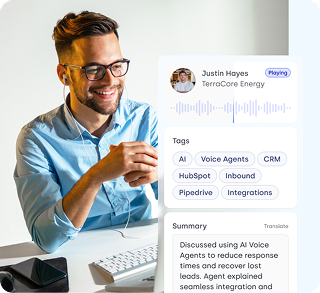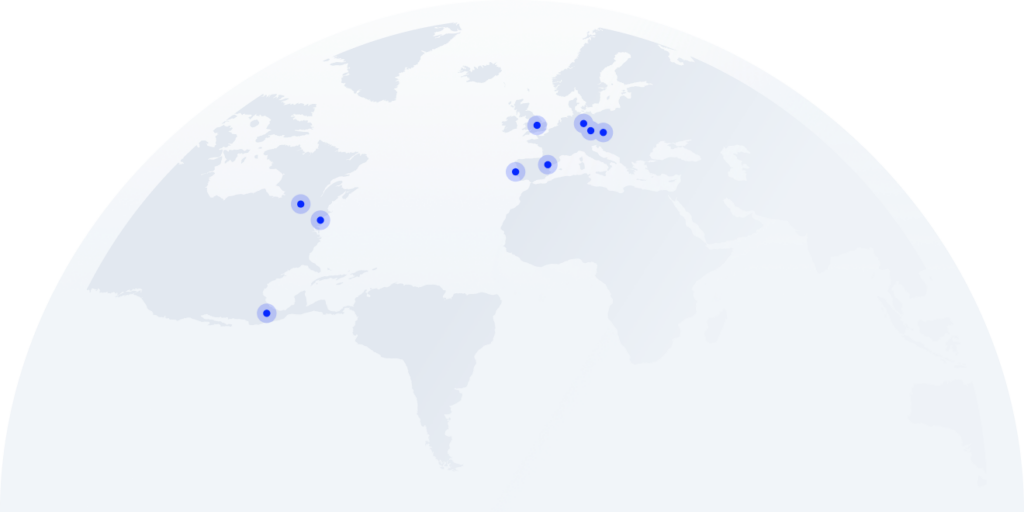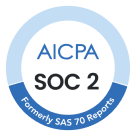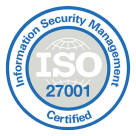Are your agents still chained to their desks by headsets? Break free from the past—SaaS contact centers let your business take off and free your team to work from the cloud.
Legacy phone systems come with entangled wires that keep your call center tied to costly hardware, maintenance, and complex setups. SaaS call centers cut the cord, giving you a more efficient, scalable cloud solution—accessible with just a browser and a login.
No surprise then that nearly 65% of organizations are integrating cloud-based telephony solutions to streamline operations and reduce their dependency on outdated hardware¹.
In this guide, we’ll break down exactly what a SaaS call center is, how it works, and why so many businesses are making the switch.
Key Takeaways
-
A SaaS contact center is a cloud-based phone system that uses VoIP (Voice over Internet Protocol) to support customer interactions over the phone.
-
With lower costs, seamless scaling, and built-in flexibility, SaaS call centers are built for speed, simplicity, and modern CX.
-
From smart call routing to real-time analytics, SaaS contact centers come packed with features that streamline workflows, boost performance, and elevate customer experience.
-
When choosing a solution, look for one that’s easy to use, quick to scale, and built to integrate seamlessly with the tools your team already relies on.
Is your call center stuck in wires? Cut them with CloudTalk.

What Is a SaaS Contact Center?
Let’s start with the basics.
SaaS stands for Software as a Service. That means you can use the software as if it were a utility—like water or electricity. Instead of installing it on your company’s computers or servers, you just subscribe to it and access it online. Well-known examples of SaaS include Netflix, Canva, and Google Workspace.
Now apply that same logic to a call center.
A SaaS contact center is, in other words, a modern cloud-based phone system. Your team doesn’t need desk phones, server rooms, or complex IT setups. All they need is a browser and an internet connection.
Here’s what makes it click:
-
The software is hosted online (by the provider), not installed locally.
-
You pay monthly, like a subscription—not a massive upfront cost.
-
Updates, maintenance, and security? Handled by the provider.
-
Your agents can work from anywhere.
So instead of the traditional “call center in a building,” you get a virtual call center software that’s lighter, faster, and way more flexible.

Take CloudTalk for a Spin (No Wires Attached)

On-Premises vs. SaaS Call Center
They may have been built for the same job—handling calls—but that’s where the resemblance ends. Understanding how these systems work isn’t just technical—it’s strategic. Let’s break it down.
Traditional Call Center Systems
Traditional call center systems ran on landlines, connected by physical hardware and miles of cable. At the center was a PBX (Private Branch Exchange)—a mini phone network that connected multiple phone lines and handled call routing behind the scenes.
Here’s how it worked:
-
Every agent’s phone was hardwired into the system via jacks and physical lines.
-
The PBX managed incoming calls and routed them based on availability.
-
If all lines were busy, callers either got a busy tone or were pushed to voicemail.
-
Internal calls were handled by the system, but only within the wired office environment.
While reliable, these systems are expensive to maintain, tough to scale, and not built for hybrid or remote teams. Adding a new agent could mean rewiring an entire section. Not exactly agile.
SaaS Contact Centers
Modern SaaS contact centers do everything traditional systems can—plus a whole lot more—and they do it entirely in the cloud.
Here’s what happens behind the scenes:
-
When a customer calls, the system uses VoIP (Voice over Internet Protocol) to route the call over the internet to any device—laptop, mobile, or desktop app.
-
It automatically checks who’s available and sends the call to the right agent or department.
-
If everyone’s busy, it queues the caller, plays a branded greeting, or redirects them to voicemail—without dropping the line.
-
Internal calls and transfers are instant and smooth, with zero hardware dependencies.
And because it’s software-based, scaling is seamless. Need to onboard five new reps tomorrow? No problem. Want to shift your support team to remote? Easy. SaaS contact centers are built for how teams actually work today.
| Parameter | Traditional On-Premises System | SaaS Contact Centers System |
|---|---|---|
| Equipment | Relies on traditional phone equipment like corded phones and analog systems. | Utilizes internet-based equipment such as IP phones, softphones, or computer-based systems. |
| Features | Basic features include call waiting, caller ID, and voicemail. | Offers advanced features like virtual numbers, smart routing, and app integrations. |
| Cost Structure | High upfront capital expenditure for equipment. | Subscription-based, lower upfront costs, pay-as-you-go. |
| Installation/ Set-up Fees | $0–$200 (depending on location) | $0 |
| Maintenance | Requires in-house IT staff for maintenance and updates. | Managed by the service provider with minimal IT involvement. |
| Internet Reliability | Not dependent on the internet; provides stable connectivity. | Relies on a stable internet connection. |
| Scalability | Limited by physical hardware capacity. | Highly scalable, easy to add/remove users and features. |
| Best For | Businesses prioritizing reliability and security over growth. | Businesses of all sizes looking to automate processes and expand outreach. |
Key Business Benefits of SaaS Call Centers
SaaS call center software doesn’t just change where your calls happen—it changes everything about how your team works.
1. Lower Costs
SaaS call centers powered by VoIP eliminate the hidden costs baked into traditional phone setups. There’s no bulky PBX hardware to install, no tangled wiring, and no surprise maintenance bills—just a single, cloud-based platform that handles calls, data, and workflows in one place.
Switching to a SaaS contact center solution can cut communication costs by up to 45%². That’s thanks to transparent, subscription-based pricing, no installation fees, and significantly lower rates for both local and international calls.
2. Easy to Set Up & Scale
Forget lengthy installations or complicated server setups—SaaS call centers get you up and running in hours, not weeks. And when it’s time to grow, adding new numbers or agents takes only a few clicks, with zero drama.
Whether you’re driving global expansion or dealing with sudden spikes in demand, call center SaaS infrastructure gives you the flexibility to scale at your own pace without friction.
Platforms like CloudTalk make that even simpler. You can set up your account and adjust the size of your team from one clean, intuitive dashboard. Here’s what that looks like:
3. Built for Flexibility
With a SaaS contact center, your phone system goes wherever your team does. Agents can handle calls from softphones on their laptops, smartphones, or browser-based apps.
The result is a team that responds faster and collaborates more effectively, no matter where they are. This flexibility translates into greater efficiency and can boost company productivity by up to 20%.²
4. Seamless Integrations
SaaS call center software shouldn’t work alone. It integrates with your CRM, helpdesk, e-commerce platform, and more—so every tool speaks the same language.
Agents instantly see caller history, notes, and context right inside the interface. No need to dig, toggle, or repeat steps—just faster, smoother service.
CloudTalk makes contact center integration easy. It connects with over 100 tools—so whether you’re working in Salesforce, HubSpot, or Zendesk, your team has the context they need, right where they need it.
5. Always Up to Date
Waiting on IT to roll out patches? Not with SaaS. Updates happen automatically in the background, so you’re always running the latest version—no downtime, no manual work.
Your team instantly benefits from new features and ongoing performance upgrades—without ever having to think about it.
No delays. No tech debt. Just a platform that keeps improving while you focus on what matters. That’s what staying ahead really looks like.
6. Increased Security
From end-to-end encryption to role-based access controls and redundant cloud infrastructure, SaaS call centers keep your data protected across every touchpoint.
Security certifications, regular audits, and automatic updates help ensure you’re always protected against emerging threats.
You also benefit from the provider’s commitment to ongoing compliance. CloudTalk, for example, takes security seriously. The platform is built to meet industry standards and complies with regulations like GDPR and HIPAA.
7. Crystal-Clear Call Quality
Modern contact center systems are built for clarity. Advanced routing technology automatically selects the best available network path, minimizing lag, jitter, and dropped calls—so every conversation sounds crisp and uninterrupted.
With a strong internet connection, SaaS contact centers can rival—and often surpass—the clarity of traditional landlines. And when your provider offers direct, operator-level connections in multiple countries (like CloudTalk), you get consistently high-quality calls, wherever you’re dialing.
Give Us 15 Minutes. We’ll Change How You See Call Centers
Key SaaS Contact Center Features
Contact center software features aren’t just boxes to tick; they shape the entire customer experience. These are the ones that keep your team efficient and your customers happy:
Smart Call Routing
Smart call routing makes sure every caller lands in the right hands—right away. It uses real-time data like time of day, language, location, or caller history to direct calls where they’ll be handled best.
With options like Caller-Based Routing (based on past behavior or source) and Skill-Based Routing (matching callers with agents who have the right expertise), solutions like CloudTalk help you handle incoming calls the smart way. They reduce transfers, speed up resolutions, and give customers a smoother experience from the start.

Call Recording & Transcription
Call Recording captures every conversation in full—perfect for training, compliance, or when you just need to double-check the details. Agents can stay present and focused, knowing nothing gets lost.
Add Call Transcription, and those recordings become instantly searchable. Managers can scan for key moments in seconds, while teams follow up with clarity—no need to scrub through hours of audio.
Voicemail & Voicemail Drop
Voicemail in SaaS contact center is streamlined and smart—quick to access, easy to manage, and fully integrated into your call flow. Each message is automatically logged to the customer’s profile, so nothing slips through the cracks.
The other way around, Voicemail Drop lets reps choose from a library of pre-recorded messages tailored to different audiences or scenarios. Whether it’s a friendly follow-up or a quick reminder, they can leave the perfect message with one click.
IVR (Interactive Voice Response)
Think of IVR as your always-on front desk. It greets callers, guides them through custom menu options (press 1 for Sales, 2 for Support), and automatically routes them to the right team—no human intervention needed.
It can also gather key info upfront, like account numbers or issue types, so agents pick up the call already prepped. The result? Faster resolutions, less friction, and a more professional experience from the very first “hello.”
Call Analytics & AI Insights
Call Analytics give you a real-time view into what’s actually happening on your phone lines—from call volume and wait times to agent performance and peak hours. It’s actionable visibility that helps you fine-tune staffing, training, and daily operations.
Layer in CloudTalk’s AI Conversation Intelligence, and your data starts working even harder. It can detect sentiment, flag calls that need follow-up, and even prioritize urgent conversations automatically. You’re not just tracking performance—you’re uncovering patterns, predicting needs, and equipping your team to act faster and smarter.
Auto Dialers
No more finger-cramping, tab-switching, or waiting on endless rings. Auto dialers take care of the grunt work—calling down your list, skipping over voicemails and dead ends, and queuing up the next live conversation automatically.
CloudTalk brings it all together with a single platform that supports multiple dialing modes (power, preview, parallel) and lets you dial up to 10 numbers simultaneously. You can balance volume with quality and keep outreach aligned with your goals.

AI Voice Agents
Think of AI Voice Agents as your always-on frontline. They don’t sleep, don’t miss a single call, and never make customers wait on hold. Perfect for handling common inquiries, capturing lead details, or helping with routine tasks.
Powered by natural language processing (NLP), machine learning, and voice recognition, they are able to comprehend conversational language. The result? Natural, human-like interactions that feel less like tech and more like someone willing to help.
That’s exactly how CeTe, CloudTalk’s AI Voice Agent, works. It speaks multiple languages, follows up, calls back, and even reaches out before leads go cold.

AI Voice Agents
Sales Reminder
Agent
Client
Sales / Marketing
Course Inquiry
Agent
Client
Education / EdTech
Payment Reminder
Agent
Client
Financial Services
Healthcare Intake
Agent
Client
Healthcare
Insurance Intake
Agent
Client
Insurance
T&C Acceptance
Agent
Client
Legal Services
Legal Intake
Agent
Client
Legal Services
Candidate Feedback
Agent
Client
Recruitment / HR
Applicant Pre-screen
Agent
Client
Recruitment / HR
Action Reminder
Agent
Client
SaaS / Software & Apps
Subscription Renewal
Agent
Client
SaaS / Software & Apps
CX Feedback
Agent
Client
SaaS / Software & Apps
Post-Sales Feedback
Agent
Client
SaaS / Software & Apps
Trial Signup
Qualifier
Client
SaaS / Software & Apps
What to Look for in SaaS Call Center Software
To find the right fit for your team and goals, here are the essentials to keep on your radar:
-
Scalability: Choose a solution that grows with you—supporting more agents, higher call volumes, and evolving workflows without disruption.
-
Multichannel support: Look for a multichannel contact center that handles voice, SMS, WhatsApp, and the channels you need in one place.
-
CRM integration: Make sure it connects with your existing CRM to unify customer data and give agents full context during every interaction.
-
Automation and AI: Features like IVR, smart routing, and AI Voice Agents can streamline operations and free up your team for higher-value tasks.
-
Real-time reporting and analytics: Real-time Dashboards and live metrics help you monitor performance, spot trends, and make data-driven decisions on the fly.
-
Call recording and quality tools: Tools for call monitoring and evaluating calls are key to maintaining high service standards and coaching your team.
-
Workforce management: Forecasting, scheduling, and adherence tracking features help you allocate resources efficiently and manage teams more effectively.
-
Security and compliance: Ensure the platform meets regulations like HIPAA or TCPA and includes strong security measures to protect customer data.
-
Customization and flexibility: You should be able to design call flows, branding, and workflows to match your business needs—not the other way around.
-
Ease of use and training: Look for intuitive design, a low learning curve, and built-in support resources to help your team hit the ground running.
-
Pricing and ROI: Understand the contact center software pricing model—per user, per minute, or bundled—and weigh it against the value and efficiency gains you expect.
The 10 Best SaaS Contact Center Providers
To make your search easier, we’ve compiled a list of the top 10 SaaS call center providers.
| Provider | Starting Price | Key Features | Best For |
|---|---|---|---|
| CloudTalk | $19 per user/month | Auto Dialers, Call Monitoring, IVR, Call Notes, Call Flow Designer, Campaigns | Growing SMBs needing versatile call management |
| Aircall | $30 per user/month | Automatic Call Distribution, Call Monitoring, Call Recording, Call Routing | Small businesses focusing on daily sales and support |
| JustCall | $19 per user/month | Automatic Call Distribution, Call Recording, Call Masking, Conference Calls | SMBs requiring advanced features and reliable systems |
| RingOver | $21 per user/month | Call Recording, IVR, Call Monitoring, Analytics Dashboard | SMBs seeking an all-in-one communication platform |
| 8×8 | Not disclosed | IVR, Skills-Based Routing, Call Center Analytics, Call Monitoring | Businesses with a global customer base |
| Dialpad | $15 per user/month | AI Transcription, Google Workspace Integration, Video Conferencing Tools | Teams leveraging AI for productivity and insights |
| RingCentral | $20 per user/month | Video Conferencing, Omnichannel Communication, Customizable Analytics | Businesses unifying communication tools |
| Nextiva | $20 per user/month | Advanced Call Queues, CRM Tools, IVR Features | Businesses needing robust multi-channel solutions |
| Vonage | $13.99 per user/month | Custom API Integrations, Ring Groups, Single Sign-On | Companies with tailored communication needs |
| Talkdesk | $85 per user/month | Call Routing, IVR, Workforce Management, AI Automation | Customer-centric businesses needing scalability |
Why Trust Our Software Review?
For nearly 10 years, we’ve been helping more than 30,000 professionals with our solutions. Along the way, we’ve worked closely with experts across customer support, sales, and operations—listening to their challenges and following market trends.
To support better software decisions, we’ve reviewed over 200 software tools across industries. In the process, we’ve analyzed 5,500+ verified customer reviews from platforms like G2, Gartner, Capterra, and TrustRadius, plus real discussions on Reddit and Quora.
In the last year alone, we published over 1,000 articles—each one written by humans for humans, with care and a deep understanding of our customers’ needs. The reviews are based on trustworthy data, with one clear goal: to provide reliable insights and answers for you.
Learn how we keep our content integrity and our software review methodology.
#1: CloudTalk
CloudTalk leads the way in AI-powered business calling software, purpose-built to enhance the performance of sales and customer support teams. Trusted by more than 4,000 innovative SMBs, CloudTalk ensures crystal-clear call quality in 160+ countries, enabling teams to have meaningful, results-driven conversations.
Best for: Compatible with businesses of all sizes, with a focus on growing SMBs
Pricing:
-
Lite plan (Americas): $19 per user/month billed annually
-
Starter plan: $25 per user/month billed annually
-
Essential plan: $29 per user/month billed annually
-
Expert plan: $49 per user/month billed annually
-
Custom plan: Contact our team for a tailor-made offer
Get a better understanding of CloudTalk’s prices and plans.
Key features:
Rating:
-
Capterra: 4,4 / 5 – 263 reviews
-
G2: 4,3 / 5 – 1,158 reviews
| Pros | Cons |
|---|---|
| Easy to use and set up, with an intuitive interface | Onboarding coach starting from the Expert plan |
| Provides reliable support for cloud-based phone systems | There is no support for landlines and traditional PBX |
| Robust package of calling features and AI-powered tools | Lack of omnichannel capabilities (email, video conferencing, etc.) |
#2: Aircall
Aircall is a powerful calling solution trusted by over 15,000 clients worldwide. It’s built to accelerate sales processes, enhance communication with prospects, and drive deal closures. With call-handling features, CRM integrations, and Analytics, Aircall streamlines workflows and empowers teams to connect more effectively.
Best for: Primarily targeted at small businesses using the phone to conduct sales and support business daily.
Pricing:
-
Essential plan: $30 per user/month, billed annually
-
Professional plan: $50 per user/month, billed annually
-
Custom plan: Price-upon-request
Get a better understanding of Aircall’s prices and plans.
Key features:
-
Automatic Call Distribution
-
Call Recording
-
Call Routing
Rating:
-
Capterra: 4,3 / 5 – 427 reviews
-
G2: 4,3 / 5 – 1,144 reviews
| Pros | Cons |
|---|---|
| Plans offer comprehensive features across tiers | High starting price and advanced features through add-ons. |
| Provides a great set of call-handling features | Lacks essential video calling and webinar hosting features |
| Easy to set up and straightforward interface | Users have reported inconsistent call quality, with echoes and disconnections |
#3: JustCall
JustCall is a modern call center solution designed to help teams scale efficiently while minimizing complexities, as claimed by the provider. While feature-rich, lower-tier plans have usage caps, it is essential to evaluate your business needs carefully.
Best for: Well-suited for small and medium-sized businesses that need a reliable phone system with advanced features.
Pricing:
-
Essentials plan: $19 per user/month billed annually
-
Team plan: $29 per user/month billed annually
-
Pro plan: $49 per user/month billed annually
-
Business plan: Price-upon-request
Get a better understanding of JustCall’s prices and plans.
Key features:
-
Call Masking
-
Conference Calls
Rating:
-
Capterra: 4,2 / 5 – 212 reviews
-
G2: 4,3 / 5 – 2,055 reviews
| Pros | Cons |
|---|---|
| Real-time sentiment analysis during calls | Transcription limited to English only |
| Efficient automated call distribution | No visual call flow designer |
| Seamless CRM data synchronization | Restricted API customization options |
#4: RingOver
Ringover is a cloud-based communication platform that unifies calls, SMS, video conferencing, and more into a single interface. Designed to enhance customer interactions and boost sales efficiency.
Best for: Small to medium-sized businesses seeking an all-in-one communication solution.
Pricing:
-
Smart plan: $21 per user/month billed annually
-
Business plan: $44 per user/month billed annually
-
Advanced plan: $54 per user/month billed annually
Get a better understanding of RingOver’s prices and plans.
Key Features:
Rating:
-
G2: 4.6 out of 5 – 165 reviews
-
Capterra: 4.6 out of 5 – 509 reviews
| Pros | Cons |
|---|---|
| The Smart plan is more affordable than most other competitors | Numerous hidden fees and handy features require add-ons |
| Efficient automated call distribution | No visual call flow designer |
| Access to onboarding portal, help center access, and email and phone support | Based on review portals, customer service can be slow to respond. |
#5. 8×8
8×8 is a well-regarded communication platform with a global reach, chosen for businesses with international operations. Its scalable design ensures it can grow alongside teams of different sizes.
Best for: Businesses with a global customer base.
Pricing:
-
X2 plan: Not disclosed (used to be $24 per user/month)
-
X4 plan: Not disclosed (used to be $44 per user/month)
-
X6 plan: Not disclosed (used to be $85 per user/month)
-
X7 plan: Not disclosed (used to be $110 per user/month)
-
X8 plan: Not disclosed (used to be $140 per user/month)
Get a better understanding of 8×8’s prices and plans.
Key Features:
Rating:
-
G2: 4.2 / 5 – 199 reviews
-
Capterra: 4.0 / 5 – 302 reviews
| Pros | Cons |
|---|---|
| Plans are comparatively affordable and well-balanced | The subscription cost quickly balloons with hidden fees |
| Intuitive and user-friendly design | The initial setup can be complex |
| Centralizes operations across calls, SMS, email, and social media | Geographic restrictions for SMS and the requirement of an office for calling capabilities |
#6. Dialpad
Dialpad is a communications platform with AI features that empower customer-facing teams. While its entry-level pricing is appealing, many handy tools are locked behind premium tiers and add-ons.
Best for: Teams focusing on leveraging AI for productivity and customer insights.
Pricing:
-
Standard plan: $15 per user/month billed annually
-
Pro plan: $25 per user/month billed annually
-
Enterprise plan: Tailor-made offer
Get a better understanding of Dialpad’s prices and plans.
Key Features:
-
Integration with Google Workspace and Microsoft Teams
-
Video Conferencing Tools
Rating:
-
G2: 4.4 / 5 – 1,848 reviews
-
Capterra: 4.2 / 5 – 536 reviews
| Pros | Cons |
|---|---|
| Competitive base pricing | Numerous hidden fees and essential features require add-ons |
| Excels in video conferencing and workflow integrations | Very limited in calling features and handy tools tied to higher-tier, custom-priced plans. |
| Basic analytics and reporting for all the plans | AI analytics are available only as additional plans |
#7: RingCentral
RingCentral is a comprehensive, unified communications platform offering calls, video conferencing, and team messaging. With advanced features and integrations, it’s ideal for businesses looking to unify their communication tools under one system.
Best for: Businesses looking for an all-in-one communication solution.
Pricing:
-
Core plan: $20 per user/month billed annually
-
Advanced plan: $35 per user/month billed annually
-
Ultra plan: $35 per user/month billed annually
Get a better understanding of RingCentral’s prices and plans.
Key Features:
-
Video Conferencing Tools
-
Omnichannel Communication
Rating:
-
Capterra: 4,3 / 5 – 210 reviews
-
G2: 4,0 / 5 – 979 reviews
| Pros | Cons |
|---|---|
| Plans are comparatively affordable and offer comprehensive features | Many of the advanced features are locked behind expensive add-ons |
| Robust platform with a selection of 200+ integrations | Set up can take up to 90 days and involves an implementation fee |
| Provides business with 24/7 unlimited chat and phone support | Based on review portals, customer support is the most criticized aspect of its service |
#8: Nextiva
Nextiva is a trusted communication platform designed to keep businesses operating in-office or remotely. Renowned for its reliability and strong customer support, it serves companies seeking a robust and efficient communication system.
Best for: Businesses needing a robust and reliable phone system that works across multiple channels.
Pricing:
-
Digital plan: $20 per user/month billed annually
-
Core plan: $30 per user/month billed annually
-
Engage plan: $40 per user/month billed annually
-
Power Suite plan: $60 per user/month billed annually
Get a better understanding of Nextiva’s prices and plans.
Key Features:
-
CRM and team collaboration tools
-
Auto-attendant and IVR features
Rating:
-
G2: 4.5 / 5 – 3,239 reviews
-
Capterra: 4.6 / 5 – 902 reviews
| Pros | Cons |
|---|---|
| Combines multiple channels, including social media, chatbots, and email | Many key features require upgrades. Calls and text are only available in the second-tier plan |
| The platform is intuitive and easy to navigate | Users report mobile app problems like freezing screens, slow loading times |
| Provides responsive and knowledgeable 24/7 customer service | A considerable portion of users reported long waiting times and poor customer service. |
#9: Vonage
Vonage provides a versatile communication solution that adapts to various business needs. It’s particularly valued for its flexibility, allowing businesses to tailor their system to specific requirements.
Best for: Companies with unique requirements needing tailored communication solutions.
Pricing:
-
Mobile plan: $13,99 per user/month billed annually
-
Premium plan: $20,99 per user/month billed annually
-
Advanced plan: $27,99 per user/month billed annually
Get a better understanding of Vonage’s prices and plans.
Key Features:
-
Custom API integrations.
Rating:
-
G2: 4.3 / 5 – 465 reviews
-
Capterra: 4.1 / 5 – 309 reviews
| Pros | Cons |
|---|---|
| HD codec with adaptive bitrate optimization | Increased data usage compared to competitors |
| Competitive base pricing for different sizes of businesses | Numerous hidden fees and essential features require add-ons |
| 99.999% uptime guarantee | High resource overhead impacting system performance |
#10: Talkdesk
Talkdesk has been on the VoIP scene since 2011. Their smart-calling platform has improved the communication capabilities of over 1,800 sales and customer support teams through high-tech automation and reliable call quality.
Best for: Customer-centric businesses of all sizes that need a flexible and scalable contact center solution.
Pricing:
-
CX Cloud Digital Essentials: $85 per user/month
-
CX Cloud Essentials: $85 per user/month
-
CX Cloud Elevate: $115 per user/month
-
CX Cloud Elite: $145 per user/month
Get a better understanding of Talkdesk’s prices and plans.
Key features:
-
IVR
-
Real-time monitoring
-
Voice and screen recording
Rating:
-
G2: 4,4 / 5 – 2,398 reviews
-
Capterra: 4,5 / 5 – 727 reviews
| Pros | Cons |
|---|---|
| Offers a wide range of integrations with popular CRM systems | Some integrations require custom development, which may add time and complexity |
| Flexible cloud-based infrastructure supports scaling as your business grows. | Performance can degrade slightly during peak usage if scaling isn’t managed effectively. |
| Provides robust AI-powered tools like virtual agents and automated workflows | It can be challenging to configure without technical expertise |
How to Set Up a SaaS Contact Center
Setting up a SaaS call center is simple. Just a few smart steps and you’re ready to go. Here’s how to get started:
-
01
Define your needs: First, figure out what you’re working with. What call volume do you expect? What must-have features? And what is your realistic budget?
-
02
Choose a SaaS provider: Compare platforms carefully. And when you’re sizing up options, don’t forget to put CloudTalk side by side with the rest.
-
03
Set up your SaaS call center: Create agent profiles, assign permissions, and configure call flow and port your numbers if needed.
-
04
Measure and improve: Monitor metrics like call volume, wait times, and agent performance. Combine that with customer feedback to pinpoint areas for improvement.
When Your Calls Sound Like the Past, So Does Your Brand
Most companies pour time, money, and energy into building modern, high-tech products. But if your team is still tied to outdated phone systems, your business risks sounding like an old door-to-door salesman trying to pitch an iPhone 17.
Your customer interactions should live up to the standards of your offering. And the stakes couldn’t be clearer: 95% of customers say CX impacts their choice of—and loyalty to—a brand³.
That’s where CloudTalk can help you. Think of it as retiring the old salesman for good and replacing him with a modern, cloud-native partner who never misses a beat. With contact center SaaS, your calls become as agile as your product—fast, reliable, and built for scale.
Explore CloudTalk and see how to give your customers the experience they deserve.
Your Phone System Called—It’s Retiring.
Sources:
1. Business Telephone System Market Size & Share [2025-2034]
2. 50 VoIP Statistics to Reveal the Future of Phone Systems
3. State of Global Customer Service – Microsoft Report









































